

Inquiry-Based Learning Definition, Benefits & Strategies. Developed in the 1960s, many teachers see inquiry-based learning as a new pedagogy — meaning they have questions about how to use it and if it’s worthwhile. Like problem-based learning, proponents state that letting students investigate solutions to open questions has a range of advantages. But the pedagogy must be shaped by research-backed approaches to reap these advantages. Inquiry and the National Science Education Standards: A Guide for Teaching and Learning.
Opportunity, an obligation, and often the authority to influence the procedures and criteria used.
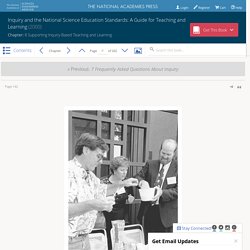
Two recent resources from the Center for Science, Mathematics, and Engineering Education will be of help in this matter (NRC, 1999a; NRC, 1999b), as will Appendix B. Nothing interferes with inquiry-based teaching more than lacking an adequate supply of instructional materials. Administrators need to ensure that teachers have appropriate kits, equipment, and supplies, and that consumable supplies are replaced regularly. Is the storage space adequate and secure? Experienced teachers can help find the answers to some of these questions, as can administrators who pay attention to the problems teachers are having. Only by working through management questions can a teacher construct an image and an understanding of how inquiry-based teaching will benefit his or her students (stage of concern number five).
Building support with the public cannot stop with parents. Inquiry-based Learning: Implementation. Key principles To recap, the key principles of inquiry learning are listed below. You can use them to guide the creation of your inquiry facilitation plans. Principle : All learning activities should focus on using information-processing skills (from observations to synthesis) and applying the discipline "ground rules" as a means to learn content set in a broad conceptual context. : Inquiry learning puts the learner at the center of an active learning process, and the systemic elements (the teacher, instructional resources, technology, and so forth) are prepared or aligned to support the learner. Principle : What is assessed is what is valued. 10 Ideas for Excellent Inquiry-Based Learning. Inquiry-Based Tasks in Social Studies.
Many schools, both nationally and internationally, are adopting the College, Career, and Civic Life (C3) Framework for Social Studies State Standards. Some states, districts, and schools adopt the full framework and standards, and others adopt the general framework, but modify or create their own grade-level standards. An important element of the framework either way is something called the Inquiry Arc. The Inquiry Arc comprises four dimensions: “one focused on questioning and inquiry; another on disciplinary knowledge and concepts relating to civics, economics, geography, and history; another on evaluating and using evidence; and a final one on communicating and taking action.”
The basic idea is that students ask or are given compelling questions and then investigate those questions, evaluate and find evidence to answer them, and communicate their answers. For example, middle school students might be given the question “Can disease change the world?” The Inquiry Design Model for Tasks. Inquiry-based Learning: Demonstration. The 5-Step Inquiry Lesson Plan - Corwin Connect. Inquiry classrooms are magical places; creative, student-driven, and dynamic.
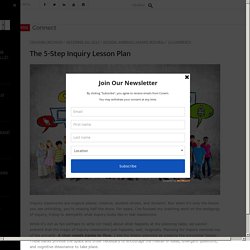
But when it’s only the lesson you see unfolding, you’re missing half the show. For years, I’ve focused my coaching work on the pedagogy of inquiry, trying to demystify what inquiry looks like in real classrooms. While it’s not as fun perhaps to write (or read) about what happens at the planning table, we cannot pretend that the magic of inquiry-classrooms just happens, well, magically. Planning for inquiry reminds me of the proverb: A river needs banks to flow. I see my lesson planning as creating the proverbial ‘banks.’ In fact, I’ve found that lesson planning is the most creative part of my job. Step 1: Connect with and question the content as a person, not as a teacher Take off your teacher hat for a moment.
What the Heck Is Inquiry-Based Learning? Inquiry-based learning is more than asking a student what he or she wants to know.
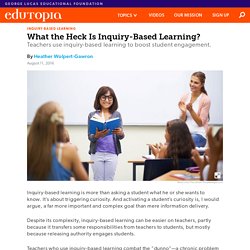
It’s about triggering curiosity. And activating a student’s curiosity is, I would argue, a far more important and complex goal than mere information delivery. Despite its complexity, inquiry-based learning can be easier on teachers, partly because it transfers some responsibilities from teachers to students, but mostly because releasing authority engages students.
Teachers who use inquiry-based learning combat the “dunno”—a chronic problem in student engagement. Inquiry Method. 4 Phases of Inquiry-Based Learning: A Guide For Teachers. 4 Phases Of Inquiry-Based Learning: A Guide For Teachers by Terry Heick According to Indiana University Bloomington, Inquiry-based learning is an “instructional model that centers learning on a solving a particular problem or answering a central question.
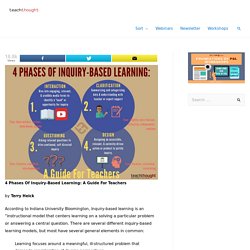
There are several different inquiry-based learning models, but most have several general elements in common: Learning focuses around a meaningful, ill-structured problem that demands consideration of diverse perspectives Academic content-learning occurs as a natural part of the process as students work towards finding solutions Learners, working collaboratively, assume an active role in the learning process Teachers provide learners with learning supports and rich multiple media sources of information to assist students in successfully finding solutions Learners share and defend solutions publicly in some manner” The process itself can be broken down into stages, or phases, that help teachers frame instruction. 1.
10 Benefits Of Inquiry-Based Learning. 10 Benefits Of Inquiry-Based Learning by TeachThought Staff Inquiry-based learning is a term that educators and parents alike hear bandied about without a clear sense of exactly what it is, why it’s effective, how it works, and what its benefits are.
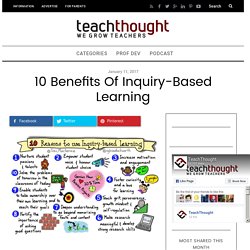
For now, let’s define inquiry-based learning simply as an open-ended approach to learning guided by students through questions, research, and/or curiosity. Sketch-noter Sylvia Duckworth took Trevor MacKenzie’s ideas on the benefits on inquiry-based learning and put together the image above. We’ve linked to a few of our resources on some of the highlights below for extended learning and reflection. 10 Tips For Launching An Inquiry-Based Classroom. Transforming teaching practices is a long, slow road. But increasingly schools and teachers experiencing success are sharing their ideas online and in-person. Science Leadership Academy opened as a public magnet school almost ten years ago in Philadelphia. The educators that make up the school community have spent nearly half that time sharing best practices through a school-run conference each year and more recently by opening a second school in Philadelphia.
Diana Laufenberg was one of the first SLA teachers and has gone on to help foster inquiry at schools around the country, most recently by starting the non-profit Inquiry Schools. 20 Questions To Guide Inquiry-Based Learning. 20 Questions To Guide Inquiry-Based Learning Recently we took at look at the phases of inquiry-based learning through a framework, and even apps that were conducive to inquiry-based learning on the iPad.
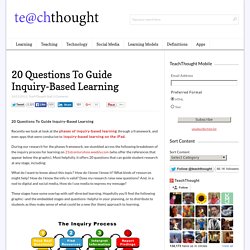
During our research for the phases framework, we stumbled across the following breakdown of the inquiry process for learning on 21stcenturyhsie.weebly.com (who offer the references that appear below the graphic). Most helpfully, it offers 20 questions that can guide student research at any stage, including: What do I want to know about this topic? How do I know I know it? These stages have some overlap with self-directed learning. References Cross, M. (1996). Bringing Inquiry-Based Learning Into Your Class. In the shallow end of the Types of Student Inquiry pool, Structured Inquiry gives the teacher control of the essential question, the starting point—for example, “What defines a culture?”
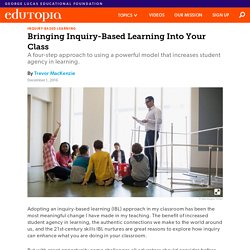
Or “What is the importance of the scientific method?” These questions are not answered in a single lesson and do not have a single answer, and, in fact, our understanding of an essential question may change over time as we research it. In Structured Inquiry, the teacher also controls specific learning activities, the resources students will use to create understanding, and the summative assessment learners will complete to demonstrate their understanding. In Controlled Inquiry, the teacher provides several essential questions. Learners unpack several resources predetermined by the teacher to provide valuable context and rich meaning relative to the essential questions. How Are the Types of Student Inquiry Helpful? Inquiry is most successful when strongly scaffolded. Creating Classrooms We Need: 8 Ways Into Inquiry Learning. If kids can access information from sources other than school, and if school is no longer the only place where information lives, what, then happens to the role of this institution?
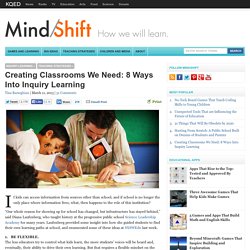
“Our whole reason for showing up for school has changed, but infrastructure has stayed behind,” said Diana Laufenberg, who taught history at the progressive public school Science Leadership Academy for many years. Laufenberg provided some insight into how she guided students to find their own learning paths at school, and enumerated some of these ideas at SXSWEdu last week. 1. BE FLEXIBLE. The less educators try to control what kids learn, the more students’ voices will be heard and, eventually, their ability to drive their own learning.
Laufenberg recalled a group of tenacious students who continued to ask permission to focus their video project on the subject of drugs, despite her repeated objections. 2. Laufenberg’s answer: Get them curious enough in the subject to do research on their own. 3. Examples of Inquiry Based Lessons. Fostering Student Questions: Strategies for Inquiry-Based Learning. Ramsey Musallam’s TED Talk on his "3 Rules to Spark Learning" inspires the need to foster students' curiosity. As educators, we want them to ask questions and explore their ideas, which can lead to a rich inquiry-based classroom. From young children whose mantra for everything is "Why? " Inquiry Based Learning - Dos and Don'ts. About ETR Community.
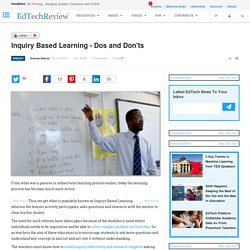
Inquiry-Based Classroom - Recherche Google. Resources and Downloads to Facilitate Inquiry-Based Learning. A Case for Curiosity: Hear from one educator on the value of asking “why?”
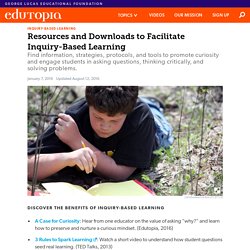
Why Inquiry Learning is Worth the Trouble. Visualization of SLA principal Chris Lehmann's 2011 talk: guiding kids' to thinking about how they think. Nearly seven years after first opening its doors, the Science Leadership Academy public magnet high school* in Philadelphia and its inquiry-based approach to learning have become a national model for the kinds of reforms educators strive towards. But in a talk this past weekend at EduCon 2.5, the school’s sixth-annual conference devoted to sharing its story and spreading its techniques, Founding Principal Chris Lehmann insisted that replicating his schools approach required difficult tradeoffs. “This is not easy. This is not perfect,” Lehmann told a crowd of devotees stuffed inside one of the Center City school’s second-floor science classrooms on Sunday.
“There are really challenging pieces of this, and we should be OK with this.” “Inquiry means living in the soup. “To me it comes down to process,” Lehmann said. “Oh God, yeah,” Lehmann said in response to the latter teacher. Related.